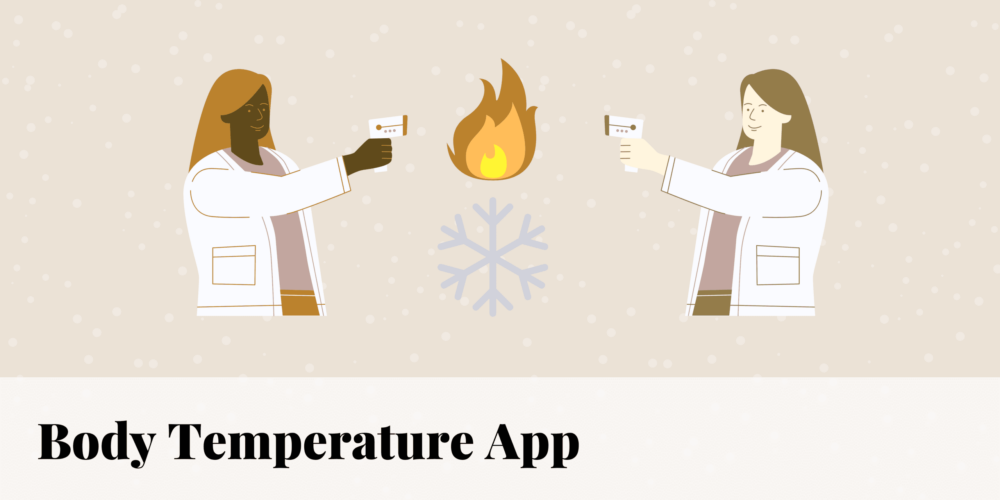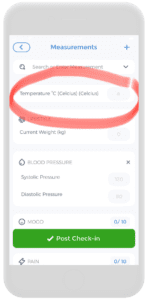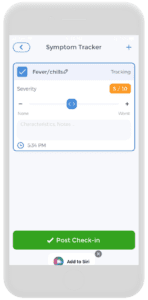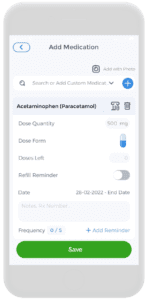
Technology has come a long way! Before all these fancy gadgets (yes, a thermometer is fancy), some may still recall the coiled wire telephone older generations had to use. Or the Motorola flip phone! That could never take our body temperature (no offense to those who had one!). It might have exploded and burned down the house.
But all jokes aside, this is probably why the thermometer was invented. For the best machine to check for a fever- and so quickly too! Yay! Taking temperature is an important concept in medicine and the field of science. Fevers, clinically speaking, can be an important sign. What those signs may mean and the different types of fever (yes, there are different kinds of fevers) will be discussed later.
Before we get into recording your temperature and inputting it into a platform to behave as your own temperature app for iPhone or for Android users… let us first discuss fevers, the reason we are taking temperature for fever, and the significance of a temperature check.
Normal Human Body Temperature
Temperature Check
The normal human temperature is considered to be 37 °C but can vary by up to 1 °C in healthy individuals (4). It is important to note that normal body temperature will vary throughout the day — it is slightly lower in the morning and usually higher in the late afternoon and evening (2). Therefore, do not be alarmed if your temperature check shows slightly lower or higher values.
Body Temperature: Using an App
Taking Temperature

- Oral (2)
- Rectal (2)
- Axillary* (Armpit) (4)
- Ear (tympanic) (2)
- Forehead (temporal artery) (2)
*least accurate method for fever measurement
Using the CareClinic Platform, available for you right in the palm of your hands, is another way to keep track of all your healthcare needs- even including recording your temperature! In the measurements function of the platform, you can add your temperature to input your values. This will help you with recording, measuring, and keeping track of the fluctuations or changes you may notice pre/post-treatment or other things your healthcare team discussed with you! This will also allow you to minimize the number of apps that are being used- all in one convenient location.
Furthermore, rectal and oral thermometers provide the most accurate measurement of core body temperature. Other types of thermometers, such as ear (tympanic membrane) or forehead (temporal artery) thermometers, although convenient, provide less accurate temperature measurements (3).
In infants, doctors generally recommend taking a temperature with a rectal thermometer. Therefore, when you report a temperature to your or your child’s doctor, it is important to not only give the reading but also, how the temperature was taken (3).
What is a Fever?
Fever Definition
“Humanity has but three great enemies: fever, famine, and war, and of these by far the greatest, by far the most terrible, is fever.” — William Osler
There are other words similar in meaning to “Fever” such as “pyrexia” or “hyperthermia” that people often use interchangeably. However, there is no consensus on this. The only thing organizations will agree on is the definition of a fever: “The American College of Critical Care Medicine, the International Statistical Classification of Diseases, and the Infectious Diseases Society of America define fever as a core temperature of 38.3 °C or higher, i.e. just above the upper limit of a normal human temperature, irrespective of the cause” (5).
Human Body Temperature Regulation
The body temperature is highly monitored in the human body. This balance is called “homeostasis”. A super important concept to keep our entire bodies in balance! Temperature is no different. Ultimately, body temperature is kept within a normal regulated limit by a delicate balance between heat loss and heat gain (4). In simpler terms, if the body gets too hot, the body will sweat it out. If it is too cold, it will shiver or do anything it can to make sure heat is retained. The human body is simply the best. In itself, it acts like your own “body temp app” without the app part.
The Fever Response
The part of the brain that is involved in regulating the core body temperature in the human body is a region called the “hypothalamus” (2,4). Think of the hypothalamus as the thermostat of your own body. Once this internal thermostat recognizes that there is a shift in core temperature, it will begin the “fever response”. This triggers a huge signal to elevate the temperature if needed. The signals details will be left out for the purpose of keeping you sane. It is an extremely complex pathway. Let us just understand that there is a signal, with the appropriate response. Fair?
Having a fever response has been noticed since ancient times. It is an adaptive body defense mechanism that leads to the appropriate immune activities, decreases bacterial or viral growth rates, and will improve host survival when foreign antigens invade the body. It has been suggested that this fever response is absolutely necessary for the survival and evolution of the human species because the response accelerates the recovery of infected individuals. To some, this fever will be a blessing. However, it can also be a curse. High fevers can also be detrimental especially if it is with co-morbidities such as severe sepsis, and pre-existing cardiopulmonary disease (4). Whichever way you want to see it, this fever response has stood the length of time.
Fever Causes
Fever or elevated body temperature can be due to the following:
- A virus (2)
- A bacterial infection (2)
- Heat exhaustion (2)
- Certain inflammatory conditions such as rheumatoid arthritis — inflammation of the lining of your joints (synovium) (2)
- A malignant tumor (2)
- Some medications, such as antibiotics and drugs used to treat high blood pressure or seizures (2)
- Some immunizations, such as diphtheria, tetanus, and acellular pertussis (DTaP), or pneumococcal vaccine (2)
Sometimes the cause of fevers cannot be identified, if you have a fever for more than three weeks and your doctor is not able to find the cause after extensive evaluation, the diagnosis may be a “fever of unknown origin”(2). But identifying the cause will be an important discussion to have with your healthcare team. Do not try to cure it yourself!
Fever Symptoms

- Sweating (2)
- Chills and Shivering (2)
- Headache (2)
- Muscle Aches (2)
- Loss of Appetite (2)
- Irritability (2)
- Dehydration (2)
- General Weakness (2)
- Febrile Seizures(2,4)**
Using the CareClinic Platform can help you keep track of these symptoms whenever they arise (because they do!). Busy days at school or work, feeling stressed or overworked/underpaid, upcoming bills, etc…will definitely take a toll on your body. You are not superhuman! Whenever a fever arises, use the symptom tracker to take note of such an incident- and to notify your healthcare team about the event.
**Children between the ages of six months and five years old may experience fever-induced convulsions, otherwise called febrile seizures. These usually involve loss of consciousness and shaking of limbs on both sides of the body. Although it is alarming for parents, the vast majority of febrile seizures cause no lasting effects. However, this would be an emergency, if the seizure lasts more than five minutes. And the doctor taking care of your child should also be notified (2,4).
Classifications of a Fever
There are two different ways to classify a fever.
Duration of a Fever
Fevers can be arbitrarily classified into acute, sub-acute, and chronic fevers based on duration (or length of time they last).
- Acute fevers are usually less than seven days in duration (4)
- Sub-acute fevers are usually not more than two weeks in duration (4)
- Chronic or persistent fevers last more than two weeks duration. These are more typical of chronic bacterial infections (4).
Height of Body Temperature
Based on the height of body temperature, fever can also be classified into low-grade, moderate grade, high grade, and hyperpyrexia.
- Normal Body Temperature: 37-38 °C or 98.6-100.4 °F (4)
- Mild/Low-Grade Fever: 38.1-39 °C or 100.5-102.2 °F (4)
- Moderate Grade Fever: 39.1-40 °C or 102.2-104.0 °F (4)
- High-Grade Fever: 40.1-41.4 °C or 104.1-106.0 °F (4)
- Hyperpyrexia: Greater than 41.1 °C or Greater than 106.0 °F (4)
Types of Fevers
The three major fever types that are known are sustained/continuous fever, intermittent fever, and remittent fever.
- Sustained/Continuous Fever: This type of fever is known as a fever that does not fluctuate more than about 1 °C (1.5 °F) during a period of twenty-four hours. However, at no time, the fever temperature will touch normal values (4)
- Intermittent Fever: this fever is defined as a fever that is present only for several hours during the day (4)
- Remittent Fever: remittent fever is known as a fever that has daily fluctuations exceeding 2 °C but will not, at no time, touch normal values (4)
Fever Treatments
There are over-the-counter medications or prescription level medications that may be necessary to help you with your fever. This, however, should be a discussion with your physician (and should not be done by yourself even if it is only over-the-counter).
Over-the-Counter Medications for Fevers

It is important to use these medications according to the label instructions or as recommended by your doctor. Be careful to avoid taking too much as taking high doses or long-term use of acetaminophen or ibuprofen may cause liver or kidney damage, and acute overdoses can be fatal (2, 3).
If it is for your child and their fever remains high after a dose, it is best to not give more medication rather, to call the doctor. Also, do not give aspirin to children because it may trigger a rare (but potentially fatal) disorder known as Reye’s syndrome (2,3).
Using the CareClinic for all your medication needs is super simple. It will keep track of all of your medications and also has the ability to give you refill reminders (if necessary). Something like having a fever and ingesting Tylenol may not warrant a refill (as long-term usage is not best suited) but can be useful for prescription medications.
Prescription Medications for Fevers
Depending on the cause of your fever, your healthcare team may prescribe an antibiotic, especially if a bacterial infection, such as pneumonia or strep throat. Not all fever causes require antibiotics! Antibiotics do not treat viral infections, but there are a few antiviral drugs to treat certain viral infections. However, the best treatment for most minor illnesses caused by viruses is often rest and plenty of fluids (2,3). Talk with your physician about which option is most suitable for you.
Treatment for Infants with Fevers
Infants (especially those younger than 28 days), babies may need to be admitted to the hospital for testing and treatment, as identifying the cause may be crucial. In babies this young, a fever could indicate a serious infection that requires intravenous (IV) medications and round-the-clock monitoring (2,3). Do not try to cure this at home!
Quick Guidelines for Fever Treatment for all Age Groups
Infants/Toddlers (2,3)
| 0-3 months | 100.4 F (38 C) or higher | Call the doctor, even if your child does not have any other signs or symptoms. |
| 3-6 months | Up to 102 F (38.9 C) | Encourage the child to rest and drink plenty of fluids. Medication is not always necessary. Call the doctor if your child seems unusually irritable, lethargic, or uncomfortable. |
| 3-6 months | Above 102 F (38.9 C) | Call the doctor; which may recommend that you bring the child in for an exam. |
| 6-24 months | Above 102 F (38.9 C) | Give your child Tylenol, others. If your child is age 6 months or older, Advil, Motrin, others are OK, too. Read the label carefully for proper dosage. Do not give aspirin to an infant or toddler. Call the doctor if the fever does not respond to the medication or lasts longer than one day. |
Children (2,3)
| 2-17 years | Up to 102 F (38.9 C) | Encourage the child to rest and drink plenty of fluids. Call the doctor if the child seems unusually irritable or lethargic or complains of significant discomfort. |
| 2-17 years | Above 102 F (38.9 C) | If the child seems uncomfortable, give your child acetaminophen or ibuprofen. Read the label carefully for proper dosage, and be careful not to give the child more than one medication containing acetaminophens, such as some cough and cold medicines. Avoid giving aspirin to children or teenagers. Call the doctor if the fever does not respond to medication or lasts longer than three days. |
Adults (2,3)
| 18 years and up | Up to 102 F (38.9 C) | Rest and drink plenty of fluids, medication is not always necessary, call the doctor if the fever is accompanied by a severe headache, stiff neck, shortness of breath or other unusual signs or symptoms. |
| 18 years and up | Above 102 F (38.9 C) | If you are uncomfortable, take acetaminophen, ibuprofen, or aspirin. Read the label carefully for proper dosage, and be careful not to take more than one medication containing acetaminophens, such as some cough and cold medicines. Call the doctor if the fever does not respond to medication, is consistently 103 F (39.4 C) or higher, or lasts longer than three days. |
The History of the Thermometer
As mentioned before, the temperature of the human body has been used as a diagnostic sign since the very early days of clinical medicine. The earliest “thermal instruments” were developed during the sixteenth and seventeenth centuries. Hippocrates (a famous ancient Greek physician) taught that using the human hand can be used to judge the presence of fever as early as 400 BC, but actual instruments to measure temperature was not developed at this time (1).
1610- Galileo
Galileo (a famous philosopher and mathematician) made an alcohol thermoscope (by using wine) which later became the principle of the Galilean thermometer. Around 1612, Santorio Santorio calibrated this tube and went on to attempt to measure human temperature with Galileo’s thermoscope (1).
1638- Robert Fludd
However, the first illustration of a thermoscope showing an actual numerical scale was done by a man named Robert Fludd. Therefore, it was only here that it was to be described as a “thermometer” (1).
1654- Ferdinand II de’ Medici
Ferdinand II de Medici, who was the Grand Duke of Tuscany, “produced sealed tubes with a bulb and stem that were partly filled with alcohol”. This was the first thermometer to depend on the expansion and contraction of a liquid, which was independent of barometric pressure. Many variants of this concept would later appear (1).
1724- Gabriel Fahrenheit
He was a German instrument-maker and he produced a temperature scale that now bears his name (The Fahrenheit scale!) (1).
1701–1741-Anders Celsius
In Uppsala, Sweden, Anders Celsius was involved in meteorological observations as an astronomy student. A large number of different thermometers existed at this point, however with all with different scales. He may have already at that early stage in his career realized that there was a need for a common international scale (1). Hence the Celsius scale we use today!!!
1848-Lord Kelvin
Located in Scotland, Lord Kelvin realized that a much greater range of temperature could be considered, far beyond the centigrade scale. Hence the Kelvin scale that scientists heavily utilize today (1).
The Clinical Thermometer
Sir Thomas Clifford Allbutt (1836–1925) was a British physician. He devised the first small clinical thermometer, which took him around 20 years. A local company, Harvey and Reynolds, first manufactured this special thermometer in 1867 (1).
From there, the technology started to expand and only get better from here. More detailed history reads for the history junkies. Enjoy!
Is there an App for Body Temperature?
Temperature App for iPhone and Android
Utilize the CareClinic platform and call this your new ” body temp app” “take your temperature app” or “check temperature app”. A place where you can record your temperature check and have a daily log of all your healthcare needs and goals. Having this app is super helpful especially if you are constantly on the go! Life gets busy— it is totally understandable. But sometimes, having an all-in-one platform to help you record and make your health profile all in one place is also super convenient.
Your new ” body temp app” “take your temperature app” or “check temperature app” can be used in conjunction with the CareClinic platform to tackle all your healthcare needs and bring you one step closer to achieving all your healthcare goals! Begin your journey today by downloading using your iOS or Android devices today by clicking here.
References
- Grodzinsky, E., & Sund Levander, M. (2019). History of the Thermometer. Understanding Fever and Body Temperature: A Cross-disciplinary Approach to Clinical Practice, 23–35. https://doi.org/10.1007/978-3-030-21886-7_3
- Mayo Clinic (n.d.). Fever. Retrieved on March 2, 2022, from: https://www.mayoclinic.org/diseases-conditions/fever/symptoms-causes/syc-20352759
- Mayo Clinic (n.d.). Fever Treatment: Quick Guide to Treating a Fever. Retrieved on March 2, 2022, from: https://www.mayoclinic.org/diseases-conditions/fever/in-depth/fever/art-20050997
- Ogoina, D. (2011). Fever, fever patterns, and diseases called “Fever”- A Review. The Journal of Infection and Public Health, 4(3), 108-124. https://doi.org/10.1016/j.jiph.2011.05.002
- Walter, E. J., Hanna-Jumma, S., Carraretto, M., & Forni, L. (2016). The pathophysiological basis and consequences of fever. Critical care (London, England), 20(1), 200. https://doi.org/10.1186/s13054-016-1375-5


